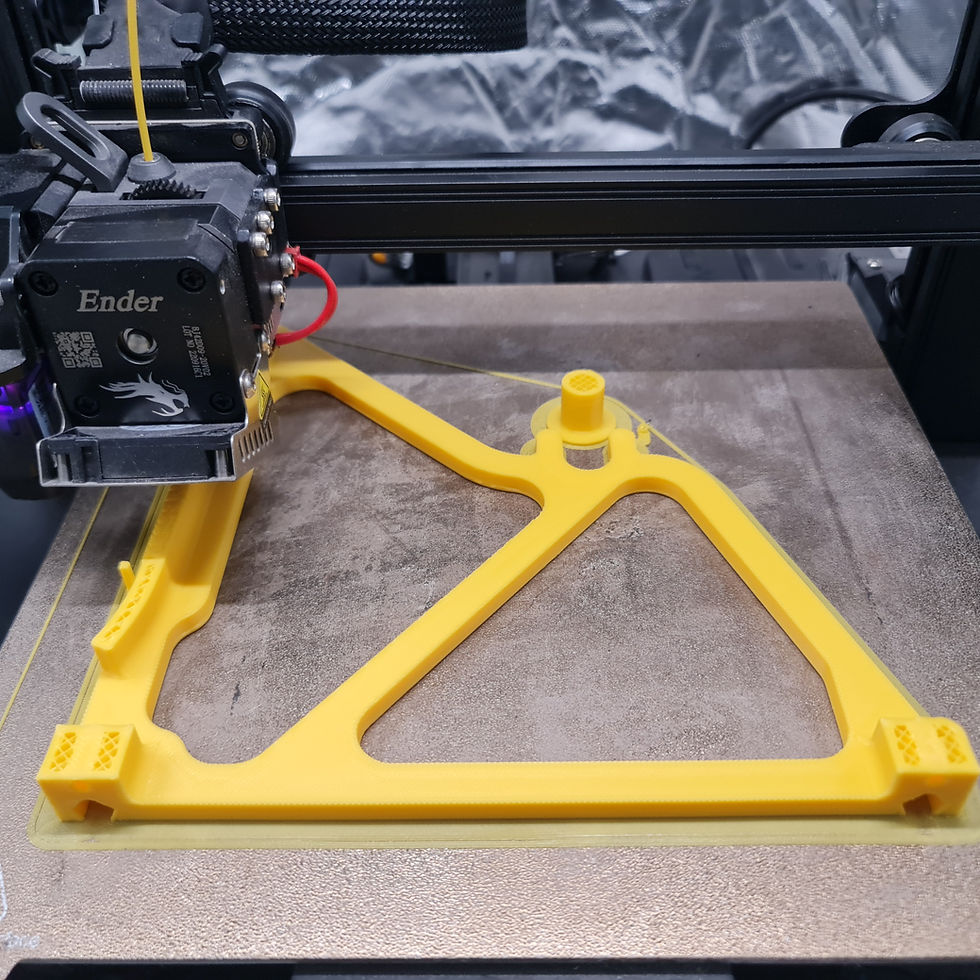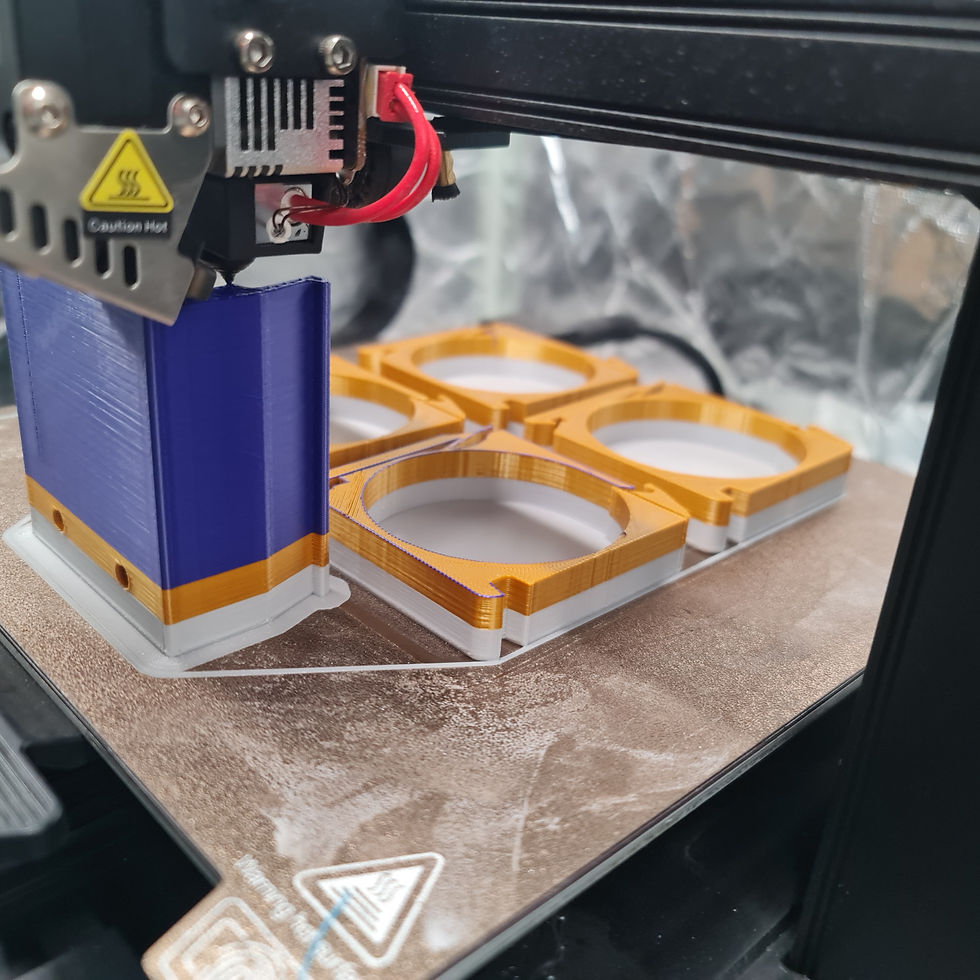What is FDM 3D Printing?
- ianmitchell1967
- Sep 18, 2023
- 5 min read
Updated: Feb 16, 2024
By Mitch
September 18th, 2023

In this article we’re going to look at what FDM 3D printing actually is and how it works. We’ll also look at the pros and cons of the method and when best to use it for your 3D printing needs.
How it works
The first thing we need to clear up is what FDM actually stands for. FDM is Fused Deposition Modelling and uses a thermoplastic filament to create 3D objects. The filament is heated and extruded to be deposited in layers to complete the object.
Sounds simple when you put it like that but there’s a lot more going on to get to the stage of having a completed object. As with any modern manufacturing process, its usual for a product to go through the design stage before final fabrication and completion of the object is finished. FDM (or any type of 3D printing) is no different in that regard.

Design
3D designs are created using CAD (Computer Aided Design) software and there are a vast number of these available to use.
Slicing
The finished design is then converted to an STL (Standard Tessellation Language) file which is what the 3D printer uses to create the object. This conversion process is carried out by “slicing” software where you can also set the desired parameters for the completed object..
STL files can be transferred to the 3D printer in various ways, dependent on the make and model of the printer.
Printing
Once the printer has the information it needs from the STL file, it uses this to map out the model and build it from the base upwards in gradual layers. There are two main parts to this process.
Extrusion
As we mentioned at the start, thermoplastic filament is used to create the layers but this needs to be extruded or “squeezed” through a heated nozzle to make the original filament thin enough to print. The most common diameter of the “raw” filament is 1.75mm and FDM printer users will usually extrude this though a 0.4mm nozzle. A typical 1KG spool of filament is approximately 330m long so once extruded, you’ll be getting just over four times that much in printed material.
The most commonly used type of filament is PLA (Polylactic Acid) as it’s cheap to buy, easy to work with and is made from environmentally friendly materials. The downside is that PLA has limitations in terms of exposure to water, chemicals and UV light so is generally used where none of these factors are likely to come into play.

Deposition
This is the part where the heated nozzle is moved based on the parameters set in the STL file and deposits the extruded filament onto the print bed. The build area of the FDM printer is defined by three axis, X, Y and Z. In most open source “gantry” style printers that you might use yourself, The X axis moves along the horizontal plane from left to right, the Y axis moves on the same plane from front to back and the Z axis moves upwards on the vertical plane.
The speed, layer height, quality etc. are all preset during the slicing stage so its just a case of checking everything is set up correctly and then letting the printer do its work.
Pro and cons
As with any machine or method of doing something there are always advantages and disadvantages, or as we like to know them, pros and cons.
There are of course pros and cons to using an FDM printer over say a resin or SLA printer. These pros can depend on which FDM printer you’re using as each one may have different features and capabilities. We’ll therefore look at the general pros and cons of the printing method as a whole.
Pros
· Easy to use: Once you’ve mastered the process it becomes second nature and this will speed up the overall printing process in the long run
· Good for prototyping: Designs can be printed easily and relatively quickly. Once you’ve got past the CAD stage then preparation for printing is a simple process
· Space saving: If you have a space to put the printer then that’s all you need. Basic printers for home use are relatively compact but there are of course much larger printers in use out there!
· Larger build volume: Basic FDM printers can produce relatively large objects, particularly when compared to basic SLA printers
· Good quality prints: Get the settings just right and your prints will be perfect. Using lower layer heights and slower print speeds for instance can greatly improve quality
Cons
· Steep learning curve: Getting to know everything can be a challenge for some and can put new users off 3D printing altogether.
· Additional costs: Failed prints cost money and replacement parts add to the expense. Home FDM 3D printers are open source so can be modified and maintained by the user but this can become expensive
· Noise/fumes: Some print filaments can give off fumes and older printers can be noisy
· Long print times: It can take days to print a large, high-quality item in some cases. Larger prints can be done in pieces but then that relies on a lot of post-processing
· Reliability: Prints can fail for many reasons such as nozzle clogging and under extrusion. This is not only frustrating but can put your project behind schedule, particularly if you’re working to deadlines
When to use FDM
If we look again at the pros listed above then that will give you a good indication of when and how to use FDM 3D printing.
In terms of prototyping, product development and manufacture, FDM printing is an invaluable tool. Prototypes can be transferred from the design table to the printer in a matter of minutes and then printed relatively quickly using PLA filament.
This however would only be useful in prototypes that aren’t expected to perform in necessarily the same way as the final product. For instance, if you print a prototype of what is going to be a metal gear system then PLA might not show the smooth working of the gears in it’s best light. You may then need to either use a harder and more durable filament type or choose a different method of 3D printing altogether.
The correct usage scenario for FDM printing would therefore also depend on the filament type to be used and we’ll be exploring that further in other articles.

FDM printing though is ideal for making interior car parts such as dash panels and door pockets. It’s also great for electrical casings and machine housings but again, you will need to use the correct filament type. There are also applications for the use of FDM printing in making prosthetics and other medical aids which is greatly helping the lives of those that need it.
Basically, FDM 3D printing can be used in any scenario where you can think that an item could be produced or reproduced in plastic. It may not give as fine detail on smaller objects than SLA does, but the versatility and possibilities f applications in both the manufacturing industries and home use could be immeasurable.





Comments